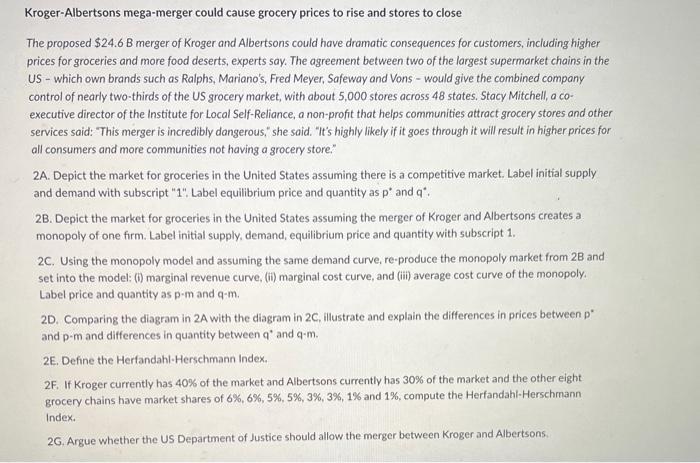Answered step by step
Verified Expert Solution
Question
1 Approved Answer
Kroger-Albertsons mega-merger could cause grocery prices to rise and stores to close The proposed $24.6 B merger of Kroger and Albertsons could have dramatic

Kroger-Albertsons mega-merger could cause grocery prices to rise and stores to close The proposed $24.6 B merger of Kroger and Albertsons could have dramatic consequences for customers, including higher prices for groceries and more food deserts, experts say. The agreement between two of the largest supermarket chains in the US - which own brands such as Ralphs, Mariano's, Fred Meyer, Safeway and Vons - would give the combined company control of nearly two-thirds of the US grocery market, with about 5,000 stores across 48 states. Stacy Mitchell, a co- executive director of the Institute for Local Self-Reliance, a non-profit that helps communities attract grocery stores and other services said: "This merger is incredibly dangerous," she said. "It's highly likely if it goes through it will result in higher prices for all consumers and more communities not having a grocery store." 2A. Depict the market for groceries in the United States assuming there is a competitive market. Label initial supply and demand with subscript "1", Label equilibrium price and quantity as p* and q". 2B. Depict the market for groceries in the United States assuming the merger of Kroger and Albertsons creates a monopoly of one firm. Label initial supply, demand, equilibrium price and quantity with subscript 1. 2C. Using the monopoly model and assuming the same demand curve, re-produce the monopoly market from 2B and set into the model: (i) marginal revenue curve, (ii) marginal cost curve, and (iii) average cost curve of the monopoly. Label price and quantity as p-m and q-m. 2D. Comparing the diagram in 2A with the diagram in 2C, illustrate and explain the differences in prices between p and p-m and differences in quantity between q' and q-m. 2E. Define the Herfandahl-Herschmann Index. 2F. If Kroger currently has 40% of the market and Albertsons currently has 30% of the market and the other eight grocery chains have market shares of 6%, 6%, 5%, 5%, 3%, 3%, 1% and 1%, compute the Herfandahl-Herschmann Index. 2G, Argue whether the US Department of Justice should allow the merger between Kroger and Albertsons.
Step by Step Solution
★★★★★
3.35 Rating (158 Votes )
There are 3 Steps involved in it
Step: 1
2A The market for groceries in the United States assuming there is a competitive market can be depicted by the following diagram Initially the demand and supply curves are labeled with subscript 1 The ...
Get Instant Access to Expert-Tailored Solutions
See step-by-step solutions with expert insights and AI powered tools for academic success
Step: 2

Step: 3

Ace Your Homework with AI
Get the answers you need in no time with our AI-driven, step-by-step assistance
Get Started


